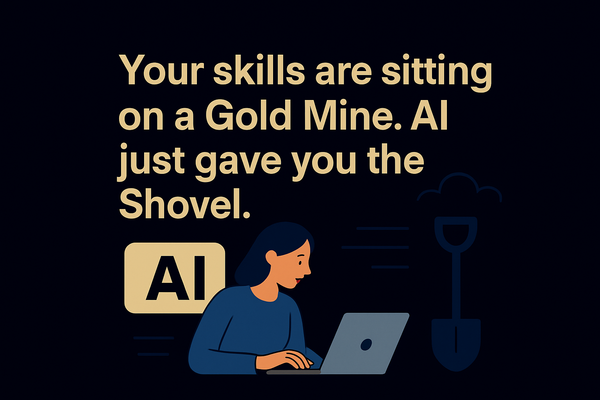AI Layoffs Are Signals. Build Sovereignty Systems. Escape Now.
Layoffs aren’t a threat—they’re a deadline. With 78% of companies using AI daily and 30% of operations automated, security is concentrated risk. Build a sovereignty system now.

More than 95,000 tech roles disappeared year-to-date, with roughly 80,000 cuts tied directly to AI automation initiatives.
AI layoffs aren't a risk—they're your sovereignty deadline.
The numbers stripped the illusion. Seventy-eight percent of companies now use AI daily. Enterprises report about 30% of their operations already automated.
Corporate loyalty is dead.
The system is designed to prioritize margins, not tenure. Roles compress as software absorbs routine work. Titles inflate as scopes shrink. Then the spreadsheet wins.
Here's what most people miss: the layoff wave is not just subtraction. Projections suggest up to 170 million new AI-related opportunities globally by year-end, with about 60% remote-friendly. The market isn't eliminating work. It's reallocating it to operators who can build and run systems.
Security was never secure. It was concentrated risk.
A salary feels stable because the variance is hidden. The real exposure is binary: employed or not. Sovereignty replaces that binary with optionality—multiple income streams, location flexibility, and control of delivery.
Systems over goals. Leverage over labor. Sovereignty over security.
If you're a high-income professional, you don't need another certification or an inspirational thread. You need an operating system that converts your expertise into a scalable, AI-assisted business that buys back your time—and insulates you from the next round of cuts.
The math is simple: replace 20-30% of your day with AI agents, reallocate the hours to building a parallel income system, compound outputs weekly, and let acquisition and delivery run on repeat.
Most will wait. A few will instrument.
The Economics of Automated Expertise
Start where the market is already moving. AI agents—from tools that live natively in your workspace to self-hosted stacks—now handle 40-60% of professional services tasks: information gathering, first-draft analysis, templated deliverables, and follow-ups. The human layer shifts to judgment, oversight, and relationship.
Your job isn't to become an engineer. It's to design a system.
The 90-Day Sovereignty Protocol
- Week 0: Decide your wedge. A wedge is a narrow, expensive problem you can solve repeatedly. Pick what you've already delivered inside a company: compliance audits, pipeline forecasting, partner enablement, clinical trial documentation, FP&A variance analysis, vendor due diligence. Don't chase novelty. Chase demonstrated pain.
- Week 1: Run a sovereignty audit. List your top three high-value skills that map to business outcomes. For each, map the delivery steps. Circle the steps that are pattern recognition, data processing, or templated creation. Those are automation targets. Leave human judgment, strategy, and relationship management in the control layer.
- Week 2: Build the minimum valuable system. Use a workspace-native agent to draft your method. Plug in automations to fetch data, trigger tasks, and generate deliverables. If a client uploads source files, the agent parses, classifies, drafts insights, and assembles your template. You review, edit, and ship.
- Week 3: Prove value in 48 hours. Choose one client-like scenario. Instrument the system end to end. Time every step. If you can cut your hands-on work by 50% while maintaining outcome quality, you have a viable engine. If not, simplify. Over-automation kills prototypes.
- Week 4: Standardize the output. Lock a single deliverable format. Consistency enables multiplication. Create your inputs checklist, your review rubric, your acceptance criteria. Name the productized service so buyers can reference it internally without you in the room.
- Week 5: Price on ROI, not hours. Anchor pricing to a conservative outcome delta. If you reduce report cycle time by 70% or eliminate a compliance risk worth six figures, price accordingly. The unit you sell is a system outcome, not your time.
- Week 6: Build the pipeline that doesn't beg. Publish a weekly, numbers-first breakdown of the problem and your method on LinkedIn. Direct-message ten warm contacts with a one-paragraph ROI hypothesis and a calendar link. Host one 30-minute small-group session walking through your architecture. No pressure. No pitches. Just math and process clarity.
- Weeks 7–8: Operationalize delivery. For every new client, your agent gathers data, drafts the analysis, fills the template, and schedules a review. Your role is oversight and escalation. Track how many minutes you spend per client and eliminate repetition weekly. The goal is a business that compounds without your exhaustion.
- Weeks 9–10: Add sovereignty to the stack. Migrate critical components you control: documentation, prompts, templates, datasets. If privacy or dependency risk matters, stand up a self-hosted model for sensitive steps. Vendor lock-in is silent compliance. Own the core.
- Weeks 11–12: Scale what is proven. Increase top-of-funnel volume by 2x. Add one adjacent use case that uses 80% of the same system. Publish outcomes, not platitudes. The system is the product. Your calendar is not.
The objection from friends still inside is predictable: "That sounds risky." Reality check: risk is failing to diversify while 30% of enterprise operations shift to automation and 78% of companies already deploy AI daily. A single income stream in a consolidating market is not conservative. It's concentrated exposure masked as normal.
The remedy is a parallel system that captures the surplus your employer can't or won't pay you for.
What to Build: Systematic Value Capture
What to build specifically? Aim for systems that convert routine complexity into standardized outcomes with clear dollars attached. Examples include AI-assisted compliance briefings that reduce audit prep hours, automated revenue attribution packages that cut weekly reporting time by 70%, or hiring screeners that filter candidates and produce decision-ready summaries with documented bias checks.
You don't need to be first. You need to be specific, fast, and measurable.
Three Metrics That Drive Sovereignty
- The Sovereignty Ratio: Non-salary income divided by total income. Target 30% within 90 days. At 30%, a layoff becomes a 70% pay cut, not 100%. That difference buys calm and time.
- Time Recapture: Weekly hours saved by your agents. Target 10–15 hours per week by week four. Recaptured time is your seed capital. Spend it on building acquisition and standardizing delivery.
- System Yield: Monthly revenue divided by your hands-on hours. Target $250–$750 per hour of founder involvement by day 90. This is not your rate—it's your system's output per unit of your attention.
Track one pipeline metric to keep yourself honest: meetings booked per week from your outbound plus content. If it's below five, fix the message or the offer; don't add features.
The Mathematics of Escape
The economic stakes are tangible. Assume a $300,000 salary. Lose it, and income drops to zero overnight. Build even a $8,000 monthly parallel system and a layoff becomes a solvable equation, not a crisis.
Twelve months later, that same engine—standardized, documented, lightly automated—can serve 5–10 clients with the same core workflow and minimal extra time. Revenue becomes a function of distribution and iteration, not exhaustion.
The psychological stakes matter more. When you own the system, you choose when to work, what to say no to, and whom to serve. Sovereignty is not retirement from responsibility. It's responsibility for your own machine.
Tactical De-Risking Protocol
- Reduce dependency: Keep your prompts, templates, and data portable. If a vendor changes pricing or policy, your core survives. Consider a sovereignty stack: a workspace agent for speed, an automation layer for glue, and a self-hosted model for sensitive steps.
- Design for compliance: If you touch regulated environments, document data flows, retention, and consent. Build ethical guardrails into agent instructions. Risk management is a feature, not an afterthought.
- Productize your credibility: Publish one process teardown weekly. Show the system, the steps, and the numbers. Authority compounds when you demonstrate reality over rhetoric.
- Price for outcomes: If your system cuts a quarterly cycle from six weeks to two, you're not selling documents. You're selling shortened cash cycles and reduced risk. That captures a share of the value you create.
- Deliver like clockwork: Most clients don't need genius. They need reliability. The agent handles repetition; you handle exceptions. Predictability converts pilots into annual contracts.
The 90-Day Checkpoint System
A practical 90-day checkpoint to keep you honest:
- By day 7, have a written process map and a one-paragraph wedge offer.
- By day 14, have an agent-assisted prototype that completes at least half the routine work.
- By day 30, have three discovery calls booked and one paid pilot scheduled.
- By day 45, ship version 1. Track time, errors, and client outcome.
- By day 60, standardize the deliverable and publish a metric-driven case note.
- By day 90, reach a 30% sovereignty ratio or a $8,000 MRR engine with under 40 hours per month of you.
None of this requires quitting first. Build while you're employed. Manual labor funds automated systems. Compliance with your current job buys search time for your own asset.
You don't escape by hoping. You escape by instrumenting.
Stop optimizing someone else's machine. Start building your own.
Your salary isn't compensation. It's rent you pay someone else to use your life. Turn that rent into ownership.
AI isn't taking your job. It's taking your excuses.
Build the system. Escape on your terms.
—The Catalyst
Disclaimer: The content provided by The Catalyst is for educational and informational purposes only and does not constitute financial, business, or professional advice. Results are not guaranteed and will vary based on individual effort, market conditions, implementation quality, and factors beyond our control. Examples and projections are illustrative and may not reflect your specific situation. Building and deploying AI systems can involve technical, legal, and regulatory considerations; conduct appropriate due diligence and consult qualified professionals before acting. You are solely responsible for your decisions and outcomes. The Catalyst assumes no liability for losses or damages arising from the use of this material.



